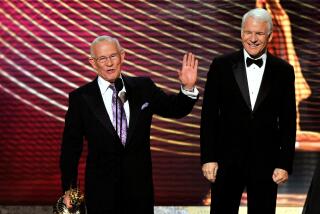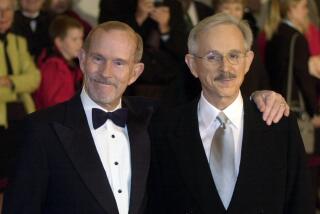At Sweet 57, Sedaka Packs ‘Em In
CERRITOS — Neil Sedaka may have been one of the first great rock songwriters, but as a performer, he is rooted in the vaudeville tradition of providing an energetic, entertaining presentation.
On Friday, in the opening performance of a two-night run at the Cerritos Center for the Performing Arts, Sedaka sang, played piano, reminisced, told jokes and tossed in a few sprightly dance steps. And he did it all with an almost perpetual smile, addingat the end of most numbersan open-armed Tony Bennett-like gesture of benediction to his enthusiastic, overflow audience.
At 57, Sedaka has been toiling in the entertainment vineyards for more than four decades. But he revealed little sense of wear and tear. His voice sounded as high and pure as it did in the years when he was cranking out such cotton candy pop fluff as “Calendar Girl,” “Next Door to an Angel” and “Sweet Sixteen” with longtime partner and lyricist Howard Greenfield. Looking trim and fit in a boxy, double-breasted, royal blue suit, Sedaka had the vim and vigor of a performer fully in his prime.
After receiving a favorable response to the question of whether anyone “remember[ed] the ‘50s and ‘60s,” he romped through a medley of his now astonishingly innocent-sounding tunes from the period. He then moved into his comeback numbers from the ‘70s: “Bad Blood” (originally recorded with Elton John), “Love Will Keep Us Together” (a hit for the Captain & Tennille), “Solitaire,” “Laughter in the Rain” and “The Hungry Years.” On “Should’ve Never Let You Go,” a tune that was a Top 20 success for Sedaka and his daughter, Dara, he was joined in a duet by dependable backup singer Jackie Berry.
In each case, the trademark Sedaka musical craft was an essential element. The primary reason he has had such a sturdy career has been his capacity to compose music with imaginative originality and a careful concern for details. Even his most recent works--based upon the somewhat quixotic lyricizing of classical themes by Puccini and Chopin--managed to come across far less like a musical conceit than an attempt to expand the horizons of a restless creative curiosity.
It was appropriate that he finished his program with a hand-clapping, spirited rendering of “That’s When the Music Takes Me.” The music, which has been taking Sedaka all over the world for most of his life, shows no signs of releasing its grasp upon this gifted performer for a long time to come.
*
Two other veteran entertainers, the Smothers Brothers, opened the show (with the help of Tommy Smothers in the persona of the fabulous Yo-Yo Man). Taking the view that if it ain’t broke, don’t fix it, the brothers continued to work their patented contentious brothers routine to absolute perfection--and with a few contemporary touches of black humor. Tommy Smothers, explaining that although the duo was not the original Smothers Brothers, noted that they were brothers. “I’m Eric,” he said, “and this is Lyle . . . Menendez. And we still don’t know who Mom liked best.”
Tommy Smothers’ incarnation as Yo-Yo Man is now a fixture in their act--a not particularly necessary supplement to a routine that has become a virtual comedy classic, but fun, nonetheless.
It’s no wonder that cable channel E! has been airing 71 episodes of the Smothers Brothers television shows, illuminated by their conversational commentary. Like Sedaka, these guys are still at the top of their form.
More to Read
The biggest entertainment stories
Get our big stories about Hollywood, film, television, music, arts, culture and more right in your inbox as soon as they publish.
You may occasionally receive promotional content from the Los Angeles Times.










